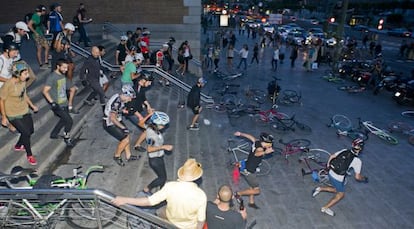Riding with Madrid’s secret bike racers
Groups of adrenalin-thirsty cyclists are holding high-speed ‘alleycat’ races around the capital

A few minutes before the start of the race, the organizers give each competitor a map with a list of landmarks they need to pass by. The racers quickly plan their route, then they’re off – pedaling at high speed, sometimes without brakes, through the center of Madrid, weaving in and out of the traffic. There is no visible start or finish line, and motorists are unaware that the cyclists around them are taking part in a so-called “alleycat:” an illegal pushbike race.
City Hall says it has no knowledge of the competitions, most of which take place on and around Paseo de la Castellana, the capital’s main north-south axis, and Gran Vía, which runs east to west. How each cyclist gets to each landmark is up to them.
Choosing different routes not only significantly reduces the possibility of jams, but makes it easier to avoid attracting the attention of police. If stopped, riders simply claim that they are in a hurry.
“You could call it punk racing,” says Piteras, one of the stars of Madrid’s illegal bike-racing scene. The 27-year-old has taken part in four alleycat races in Madrid, winning two. For him the main draw is the danger. He has also ridden races in Barcelona, but says Madrid is tougher and more fun: “There are more cars and more hills.”
Some racers use fixed-wheel bikes with no brakes that require slamming the pedals into reverse to halt
Most races take place around sunset, when traffic has eased up and there are fewer police around. Headlights make it easier for participants to judge what cars are doing and to be able to jump red lights.
Races are organized informally, and the word goes out on the social networks and through bike shops. Most races attract around 40 competitors in large cities such Barcelona and Madrid, most of whom are men in their twenties and thirties. There is little at stake except pride: if there are any prizes, they come in the form of cycling kit.
The idea comes from the United States, where for decades bike messengers have been staging races in city centers along their daytime delivery routes, sometimes to see who can finish a route quickest, and sometimes involving “tasks,” such as performing a dance at a particular spot, or racing in fancy dress.
Piteras says he likes to follow the example of the US messengers when competing. He uses a fixed-wheel bike with no brakes that requires slamming the pedals into reverse to bring to a halt, producing a rear-wheel skid.
How can we be the problem when nobody even knows what an alleycat is?”
Avoiding cars, motorbikes, pedestrians and other cyclists on a brakeless bike that can reach speeds of up to 60km/h sounds dangerous, but Piteras says it’s pretty much the same as any other journey through the city. “You take the risks you want,” he says. Participants are not obliged to jump red lights or head the wrong way down a one-way street, and argue that alleycat races are a great way to get to know the city.
Some would disagree, particularly activists campaigning to make Madrid a more bike-friendly city, such as EnbiciporMadrid (By bike in Madrid). “You hear people complaining all the time that cyclists jump red lights, and this is a problem for those of us who respect the rules,” says a spokesman.
Piteras disagrees, and says the monthly protests staged by huge groups of cyclists that hold up traffic do more harm. “How can we be the problem when nobody even knows what an alleycat is?” he asks.
He may have something there. Madrid City Hall says it is unaware of any illegally organized bike races in the capital. Competitors say that incidents with other road users or pedestrians are extremely rare. “We respect pedestrians, and we only put ourselves at risk,” says Piteras.
Tu suscripción se está usando en otro dispositivo
¿Quieres añadir otro usuario a tu suscripción?
Si continúas leyendo en este dispositivo, no se podrá leer en el otro.
FlechaTu suscripción se está usando en otro dispositivo y solo puedes acceder a EL PAÍS desde un dispositivo a la vez.
Si quieres compartir tu cuenta, cambia tu suscripción a la modalidad Premium, así podrás añadir otro usuario. Cada uno accederá con su propia cuenta de email, lo que os permitirá personalizar vuestra experiencia en EL PAÍS.
¿Tienes una suscripción de empresa? Accede aquí para contratar más cuentas.
En el caso de no saber quién está usando tu cuenta, te recomendamos cambiar tu contraseña aquí.
Si decides continuar compartiendo tu cuenta, este mensaje se mostrará en tu dispositivo y en el de la otra persona que está usando tu cuenta de forma indefinida, afectando a tu experiencia de lectura. Puedes consultar aquí los términos y condiciones de la suscripción digital.








































